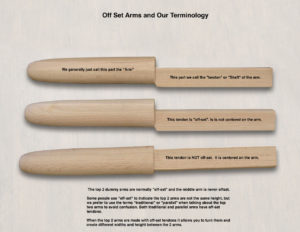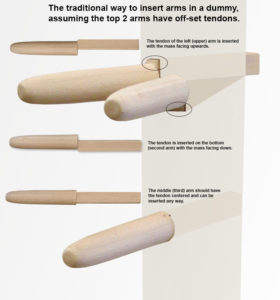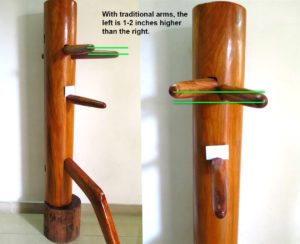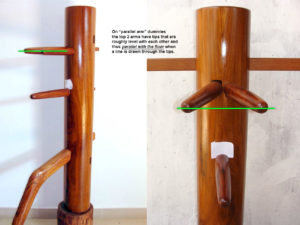The second most common question we get in regards to wooden dummies (after “What height should my wooden dummy arms be off the floor“) is, “Should I get traditional or parallel arms and what is the difference?”. So we decided to tackle that question here.
First, there is some confusion about the term “offset” arms. So let’s clear up how we use the term “offset”. You will typically hear this in something like: “the top 2 arms are offset, but the middle arm is not”. What that means is that the shaft, or tenon, of the arm that goes through the dummy, is not centered on the arm of the dummy. The middle arm is never offset (which means the shaft is perfectly centered on the arm – No matter which way you put the arm into the dummy the arm is the same height and location). “Offset” does not necessarily mean the arms are different heights because parallel armed dummies have offset tenons. What is key is how FAR the tenons are offset.
 Some people use “offset” to indicate the top 2 arms are not the same height, but we prefer to use the terms “traditional” or what is commonly referred to as “parallel” when talking about the top two arms to avoid confusion. Both traditional and parallel arms have offset tenons. When the top 2 arms are made with offset tenons it allows you to turn them and create different widths and height between the 2 arms.
Some people use “offset” to indicate the top 2 arms are not the same height, but we prefer to use the terms “traditional” or what is commonly referred to as “parallel” when talking about the top two arms to avoid confusion. Both traditional and parallel arms have offset tenons. When the top 2 arms are made with offset tenons it allows you to turn them and create different widths and height between the 2 arms.
Second, let’s show you a dummy with traditional arms and one with parallel arms. We will use Buick Yip’s dummies as they are very easy to see the difference on and he makes both kinds. To the left, you will find pictures of both traditional and parallel arms on a Buick dummy. Parallel arms have the tips of the top 2 arms roughly the same distance from the floor. The term “parallel” does not refer to the arms being parallel to each other. It refers to the fact that if you draw a line through the tips of the arms, that line is parallel to the floor. We use the term “parallel arms” because that is what many sifus call these arms, even though it is not 100% accurate. The arms themselves are level to each other, not parallel to each other. Traditional arms have the left arm tip (when facing the dummy) 1-2 inches higher than the right.
 This is a good time to clear up another issue as well, and that is how the arms are placed in a traditional dummy. Because the top 2 arms have offset tenons you can actually turn both of them 4 different ways for a total of 16 combinations. But only one combination is traditional and will get you the traditional arm setting. (And actually, this is how parallel arms are inserted into the dummy as well). You put the top (left) arm in with the tenon on the top of the arm and you put the bottom (right) arm in with the tenon on the bottom of the arm. This keeps the left-right distance to the traditional amount and makes the tips of the arms closer together vertically, which is the traditional way. Of course, feel free to put them in any way you want – it is your dummy and training.
This is a good time to clear up another issue as well, and that is how the arms are placed in a traditional dummy. Because the top 2 arms have offset tenons you can actually turn both of them 4 different ways for a total of 16 combinations. But only one combination is traditional and will get you the traditional arm setting. (And actually, this is how parallel arms are inserted into the dummy as well). You put the top (left) arm in with the tenon on the top of the arm and you put the bottom (right) arm in with the tenon on the bottom of the arm. This keeps the left-right distance to the traditional amount and makes the tips of the arms closer together vertically, which is the traditional way. Of course, feel free to put them in any way you want – it is your dummy and training.
One more tip – we see some dummies that have all 3 arms with non-offset tenons. These arms have a huge difference in height level and are not adjustable. A lot of poorly made Wing Chun dummies do not have offset tenon arms, and there is not any evidence put forth so far as to why the arms should be this way; all of the arguments are on how FAR the arms should be from one another and anything over a couple inches is generally not even mentioned as no lineage we know of uses arms so widely spaced. That is just something poor dummy designs have that is not correct.
So, now that you know about off-set arm tenons, what traditional and parallel armed dummies look like, and how to insert your dummy’s arms traditionally, they question is: which arm setting is better – traditional or parallel?
Well, the short answer is that it is pure preference – or whatever your Sifu tells you. But here are some thoughts on the matter:
Common reasons cited for using Traditional Arms:
- They are different on purpose to train the weaker arm more. This argument doesn’t hold up for many people, who claim you don’t lift more weight with your weak side to make it stronger, and when it is as strong as the other side you should then use equal weight. It does have some validity, however, because you use your dominant side more all day long, so when training if you lift your non-dominate side a little more it will help strengthen it so your arms are more balanced overall.
- Recently, Buick Yip expounded on this more for us (Oct, 2000):
The WingChun dummy is made with left arm higher for a reason.
As we all know WingChun is symmetrical, movements were equally allocated on either side, however, there’s mini adjustment towards the left side, so it really isn’t 100% symmetrical.
People were born with the tendency of the left side or the right side of the body, most people tend to be rightist because the heart is on the left side, there are still some leftists nevertheless, me for one.
In China, there’s also leftists, however, once they were spotted, the parents will discipline them to switch their habit to the right, sometimes at any cost and day and night discipline.
Chinese calligraphy can only be written by the right hand, when sit and eat on a round table, the one holding chopsticks with the left hand will keep elbowing the one sat on his left. Even scissors were made only to be used by the right hand. In the army, weapons were designed to be used by the right hand major. A southpaw will encounter various setbacks in his life time in his endeavors and mocked at as he enters the society, leftists were not being tolerated.
So assume all practitioners being rightist, the left hand (actually the left side) will be slightly weaker, adjustments were put in the practice to make up the difference.
All movements of the fist forms started with the left hand, the three punches were left-right-left. In chumkiu the last kick is only one left kick, no right kick.
The left arm of the wooden dummy were made couple inches taller than the right arm, all these for the sake of to make up the difference through minor adjustments.You might choose to post this on the site, only fewer people could have heard about this, or to keep it until someone comes up with the question, it’s nothing secret
Buick
- The techniques differ slightly from side to side. This argument could have the most weight, but as of yet no one has come forward to give examples.
- Tradition. Yip Man’s personal dummy arms were not parallel, for example. He must have known something he did not pass on.
- Some people say dummy makers didn’t know how to make them parallel in the old days. This does not make sense to many people because the inventors of the Dummy were surely as smart as we are and could have offset the arms enough to make them parallel. They did design the dummy after all. If they wanted them parallel they could have made them so – this means they should not be exactly parallel.
- The left arm is higher because most people are right handed and this represents an opponent’s right. They are more likely to hit higher (head hunt) with their dominant hand so you should train as if that side is punching higher… or something along those lines.
- Flow – it is easier to flow between techniques when the top 2 arms are slightly offset in height
- It allows you to train the techniques at different levels. When you move around the dummy, for example, you will bong sao both arms with both of your arms – thus train 2 levels with each arm. This holds some weight, but not all techniques are performed on both arms with both of your arms.
However many people today prefer the arms to be exactly parallel, especially in certain Wing Chun lineages.
Common reasons cited for using Parallel Arms:
- According to one Sifu, “It is important for the arms to be parallel when resting to ensure that the structure of your movement is equal on both sides. So unless you are fighting a deformed human or an alien who has one arm sticking out of his neck and the other out of his torso, the mook arms need to be parallel so you train correctly/equally on both sides… to keep techniques done on both sides equal. For instance, the Bong Sao with the left arm should be the same as the right Bong Sao”. This Sifu is from the Yip Man lineage. However, Yip Man’s dummy arms were not parallel, and the plans he gave Koo Sang, the famous dummy maker, Wong Shun Leung, and others did not have parallel arms.
- Human arms are parallel, so Dummy arms should be. “Regarding the arms of other dummies not being level, or close to it, this is an error on their part. The arms of an opponent (person) are level, so the dummies arms should be as close to level with each other as possible.” This common argument seems to forget that human arms can move and be various heights when they punch.
- Lack of good evidence and support of why the arms should be non-parallel by an inch or so.
So what do we think? We think that 1 argument on each side holds some weight. The arms were made in the traditional manner for a reason, but that reason has been lost. The ancestors were smart enough to make them parallel if they wanted them parallel. VS Parallel arms keep you in balance more. But honestly, there is so little difference between the two we can’t see how it matters. It is not going to mess you up to use one over the other. As a matter of fact, you need to be able to walk up to any dummy with arms at any height (or width apart) and perform the techniques flawlessly. A dummy is a tool for positioning and your position and structure are dictated by your footwork and angles of entry in relation to the opponent’s arms (which, BTW, NEVER match your dummy’s arms!). If you cannot adjust on the fly, then you are in trouble anyway. So just pick the setting you think you will like more. And if you really can’t decide, then get a dummy with arms that are switchable between parallel and traditional.
Hope that helps some!



the arms were meant to be parallel. They have to be built offset because they both have to pass through the dummy’s body. In this way, having one up and the other down, they will be parallel.
BTW-the word you are looking for is tenon, not tendon.
Hi Rik,
Just curious – why do you say the arms were meant to be parallel? There is not any evidence that we know of that shows dummies had parallel arms before students of Ip Man created dummies like this. We’d love to learn more. And thanks for the correction, the article has been updated.